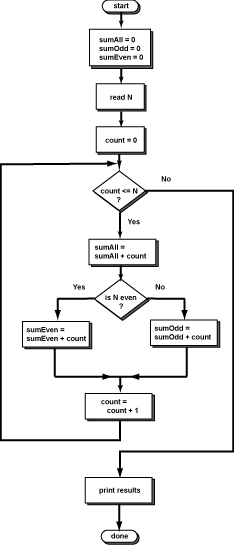Adding Up Even and Odd Integers

Here is a skeleton for the program. Compare the skeleton to the flowchart at right.
import java.util.Scanner;
// User enters a value N
// Add up odd integers,
// even integers, and all integers 0 to N
//
class addUpIntegers
{
public static void main (String[] args )
{
Scanner scan = new Scanner( System.in );
int N, sumAll = 0, sumEven = 0, sumOdd = 0;
System.out.print( "Enter limit value:" );
N = scan.nextInt();
int count = ;
while ( )
{
(more statements will go here later.)
}
System.out.print ( "Sum of all : " + sumAll );
System.out.print ( "\tSum of even: " + sumEven );
System.out.println( "\tSum of odd : " + sumOdd );
}
}
First, we should get the counting loop correct. The loop should count from zero up to (and including) the limit. It is often a good idea to write a program in stages (just as a house is built in stages). First, get the foundation correct. The foundation of this program is the counting loop.